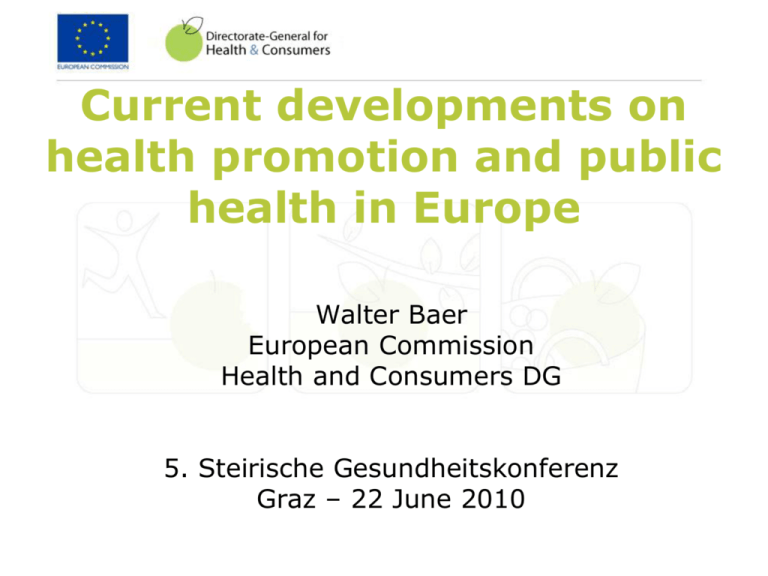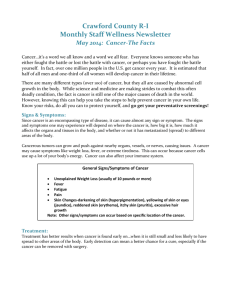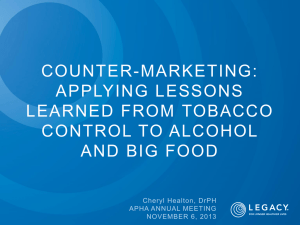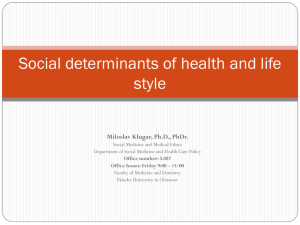The health and well being of children and young people: the EC*s
advertisement

Current developments on health promotion and public health in Europe Walter Baer European Commission Health and Consumers DG 5. Steirische Gesundheitskonferenz Graz – 22 June 2010 Overview 1. Role of Community on health 2. Current and future health challenges 3. EU Health strategy and Health Programme 4. Activities in the field of health determinants 5. Children and Young People Evolution of health action specific public health role created in 1992 by the Maastricht Treaty – and still developing but health has always been an important part of Community policies The public health article Support to Member States through networks and projects Policy actions Legislation to set European standards Blood pressure Cholesterol Tobacco High Body Mass Index Fruit and vegetable intake Physical inactivity Alcohol Urban air pollution Lead exposure Occupational carcinogens Illicit drugs Unsafe sex Occupational particulates Occupational risk factors for injury Future Challenges - Current Strategies Health investments in the Structural Funds Health information and Health Portal Expanding EU: growing health gaps Ageing Population Citizens’ Agenda European Centre of Disease prevention Safety, Pandemic andOrgane Donation Interactions with WHO Globalisation Bioterrorism Threats Lifestyle Related Diseases White paper on Nutrition Communication on Alcohol Tobacco control strategy New Technology and Innovation Migration & Cross Border Healthcare Pharmaceutical Forum Health services Initiative Health determinants Unhealthy diet CVD Cancer Type 2 diabetes Physical inactivity Tobacco use COPD Mental health Figure: Causal factors of major non-communicable disease Alcohol Musculoskeletal disorders Oral health Preventable deaths and illness 35,000 young people aged 15-24 years die each year (EU15) Accidents commonest cause of death (65%), followed by suicide 15 to 20% mental disorder Overweight and Obesity in the EU: Scene setter Obesity levels in the EU have risen by between 10-40% over the past decade. Range of obesity prevalence in EU countries is from 10% to 27% in men and up to 38% in women. Number of EU children affected by overweight (BMI >25) is estimated to be rising by more than 1,300,000 a year, of these 300,000 are becoming obese Across the entire EU25, overweight affects almost 1 in 4 children By 2010 estimated that 26 million children will be overweight and 6.4 million will be obese Obesity accounts for up to 7% of health care costs. In the EU, 9.6% of disability-adjusted life-years are lost due to poor nutrition, obesity and physical inactivity (compared with 9% due to smoking). White Paper on a Strategy on Nutrition, Overweight and Obesity related health issues Better informing the consumer, such as through better labelling on food products Making the healthy option available, such as making fruits and vegetables available to schools Encouraging physical activity, such as by encouraging community initiatives or by raising awareness of Community funds to develop the physical environment to encourage walking/cycling and other forms of activity Focus on priority groups and settings, such as children and schools Developing the evidence base to support policy making, such as by carrying out research into behaviour change in relation to food and nutrition Developing monitoring systems, such as by working with the WHO to identify effective local actions Tobacco Weekly smoking rates: 2% among 11- year-olds, 8% among 13-year-olds, and 24% among 15year-olds prevalence of weekly smoking among 15-year-old girls higher than that of boys in 18 mainly western European countries, in the others, girls are catching up Eurobarometer among 15 – 24 year olds: 57% have never smoked, 8% used to smoke but have stopped and 35% are smokers. Starting age: 10-12 years, boys ealier than girls Tobacco policy Legislation Advertising, Warning messages and pictures Products Link to international work (FCTC) Prevention work: Youth campaigns 2002-2004: ‘Feel free to say no’ 2005-2008: ‘HELP’ - 72 Mio € 2009-2011: ‘HELP 2.0’ – 16,84 Mio € for 2009 Network tobacco control initiatives Exchange Best Practice and develop European projects Help - anti-tobacco campaign Focus on: Prevention Cessation Passive smoking Target: Young people aged 15 to 24 Young adults aged 25 to 35 Motto: providing help and support by delivering information on health and social problems related to tobacco consumption, tips and advice not to start, help to quit, on passive smoking EU actions on tobacco control and national actions Conducted in partnership with communication experts, tobacco control professionals and Youth representatives. Help - anti-tobacco campaign Integrated communication campaign in 27 Member States with a comprehensive action scheme including: Media: TV spots on 96 national and Pan-European channels Internet: e-mail coaching, viral marketing (Nicomarket), banners and video placements Help website available in 22 languages A series of national events (CO measurements, Youth Manifesto promotion) After 3 years of the campaign (since March 2005): 172 million Europeans remember seeing the TV campaign 3.9 billion contacts via the media campaign (TV + Online) 60% of young Europeans remember having seen at least one TV film 77% of all Europeans and 83% of the under 25 target like the adverts. 5.2 million visits to the Help website Over 640 events run Europe-wide, and 210,000 CO tests performed Over 104,000 subscribers to the e-mail coaching programme Over 5,000 articles and reports in the media to date Mental Health – dimensions Health: at least 11% of population experience mental disorders. Each year, there are about 90,000 deaths from mental and behavioural disorders and 60,000 from suicide Economic: a loss of 3-4% of the EU‘s GDP. Main factor: productivity losses through absenteeism and reduced work performance. Social: Disadvantaged groups face a greater risk of mental illness. People with mental disorders may face stigma, discrimination and social exclusion. Mental health 2005: Helsinki conference – WHO/EU 2005: Green paper consultation – open and structured 2008: European Pact and conference Suicide and depression Young people and education Workplace The elderly 2008:Eurobarometer on Mental Health of Children and Young People 2009: Thematic Conference on the promotion of mental health and well-being of Children and Young People Recommendations for Educational Settings and Learning Including social and emotional learning programmes and life skill education at preschool and school settings Development of national action plans on mental health promotion in educational settings High quality and easily available psycho-social support for pupils, students and teachers Assure cooperation between educational settings, parents and communities Non-formal and informal learning opportunities developed within, around and outside educational settings Alcohol 25% of men and 10% of women consume too much alcohol 30% of 15 year old girls 37% of 15 year old boys report being drunk twice or more 7,5% of all ill health and early death in EU 195,000 premature deaths per year in EU 60 acute or chronic diseases caused by excessive alcohol consumption up to 25% of male premature deaths and up to 10% of female premature deaths caused by excessive alcohol consumption Alcohol 2006: Communication on alcohol-related harm Young people and children Road traffic and drink driving Adults and the workplace Information and awareness raising Evidence base Work across policies and with Member States 2007: Alcohol and Health Forum 2009: 1ST Progress Report on the implementation of the EU alcohol strategy The way forward Comprehensive approaches – looking at young personalities Life skills? Resilience? ‘Kinder stark machen’? Partnerships for health across society and locally Work with young people and their organisations Schools are key Projects from the Public Health Programme – some examples Shape Up – towards a European network for obesity prevention in children CSAP – Child Safety Action Programme ENHPS I & II – European Network of Health Promoting schools EPODE (Together Let's Prevent Childhood Obesity) In Form – Campaign against obesity in children and adolescents Smokefree Class Competition Ten D by Night (Dark, Dance, Disco, Dose, Drugs, Drive, Danger, Damage, Disability, Death) SWEET Project – Better control in paediatric and adolescent diabetes in the EU The Youth health initiative: aims Involve young people more closely in EU health policies Strengthen youth partnership in the decision making process Involve other sectors across EU policy areas and at national level on the implementation of prevention programs targeted at young people Support Member States' activities on the health of young people The Youth health initiative A roadmap on Youth health: 4 priorities on Empowerment and participation Inequalities and vulnerability Communicating health Mainstreaming these principles across EU health policy The Youth health initiative Empowerment and participation (e.g.): Development of a strategy to improve young people's sexual health Involvement of young people and a youth event during the 5th Ministerial Conference on Environment and Health Organisation of a Youth-health specific event in Torino, European Youth Capital 2010 Communicating health (e.g.) Establishment of a Clearing House of activities and projects on alcohol and youth health Workshop on tobacco control and information with the medical student working group established within the HELP 2.0 campaign The Youth health initiative Inequalities and vulnerability (e.g.): The European Conference on Injury prevention and safety promotion Workshop, in cooperation with the European Youth Forum, on how to reach and engage unorganised Youth and to raise their awareness on health issues Workshop on drugs and young people Tools (e.g.) Further development of actions on social networks (already in Facebook (http://www.facebook.com/group.php?v=wall&gid=627286 39670) Development of an electronic network on youth health Further development of the Youth Health website http://ec.europa.eu/health-eu/youth/index_en.htm Further Information Public Health Portal http://health.europa.eu SANCO Web Site http://ec.europa.eu/health Thank you very much for your attention!





